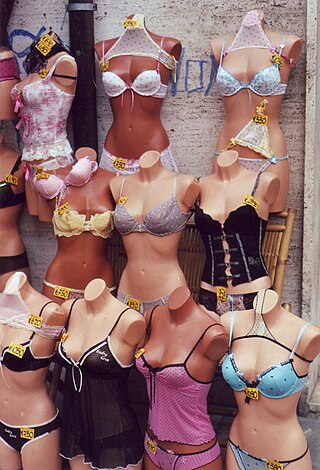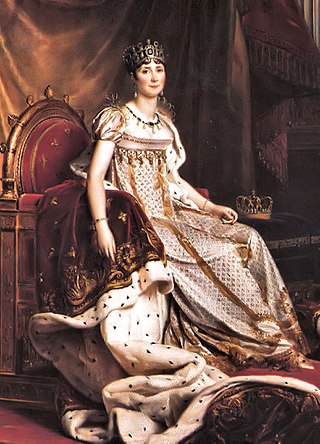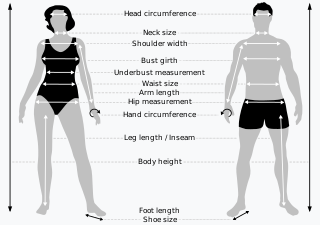
Lingerie is a category of primarily women's clothing including undergarments, sleepwear, and lightweight robes. The choice of the word is often motivated by an intention to imply that the garments are alluring, fashionable, or both. In a 2015 US survey, 75% of women reported having worn "sexy lingerie" in their lifetime.

The waist is the part of the abdomen between the rib cage and hips. Normally, the waist is the narrowest part of the torso.

The joint European standard for size labelling of clothes, formally known as the EN 13402 Size designation of clothes, is a European standard for labelling clothes sizes. The standard is based on body dimensions measured in centimetres, and as such, and its aim is to make it easier for people to find clothes in sizes that fit them.

The waistline is the line of demarcation between the upper and lower portions of a garment, which notionally corresponds to the natural waist but may vary with fashion from just below the bust to below the hips. The waistline of a garment is often used to accentuate different features. The waistline is also important as a boundary at which shaping darts can be ended.

Bust/waist/hip measurements are a common method of specifying clothing sizes. They match the three inflection points of the female body shape. In human body measurement, these three sizes are the circumferences of the bust, waist and hips; usually rendered as xx–yy–zz in inches, or centimeters. The three sizes are used mostly in fashion, and almost exclusively in reference to women, who, compared to men, are more likely to have a narrow waist relative to their hips.

The waist–hip ratio or waist-to-hip ratio (WHR) is the dimensionless ratio of the circumference of the waist to that of the hips. This is calculated as waist measurement divided by hip measurement. For example, a person with a 75 cm waist and 95 cm hips has WHR of about 0.79.

An hourglass corset is a garment that produces a silhouette resembling an hourglass shape characterized by wide hips, narrow waist, and wide bust.
Sweater design is a specialization of fashion design in which knitted sweaters are designed to fulfill certain aesthetic, functional and commercial criteria. The designer typically considers factors such as the insulating power of the sweater ; the fashion of its colors, patterns, silhouette and style lines, particularly the neckline and waistline; the convenience and practicality of its cut; and in commercial design, the cost of its production and the profitability of its price point. Sweater designs are often published in books and knitting magazines. Sweater design is an old art, but continues to attract new designers such as Nicky Epstein and Meg Swansen.
U.S. standard clothing sizes for women were originally developed from statistical data in the 1940s and 1950s. At that time, they were similar in concept to the EN 13402 European clothing size standard, although individual manufacturers have always deviated from them, sometimes significantly.

The hourglass figure is one of four traditional female body shapes described by the fashion industry. The other shapes are the rectangular, inverted triangle, and spoon/pear. The hourglass shape is defined by a woman's body measurements- the circumference of the bust, waist and hips. Hourglass body shapes have a wide bust, a narrow waist, and wide hips with a similar measurement to that of the bust. This body shape is named for its resemblance to that of an hourglass where the upper and lower half are wide and roughly equal while the middle is narrow in circumference, making the overall shape wide-narrow-wide. Women who exhibit the hourglass figure have been shown to be more admired, which can put pressure on women whose body shapes are noticeably different to strive to achieve the hourglass figure. This can lead to body dissatisfaction which can cause eating disorders in young women from all over the globe.

Clothing sizes are the sizes with which garments sold off-the-shelf are labeled. Sizing systems vary based on the country and the type of garment, such as dresses, tops, skirts, and trousers. There are three approaches:

The history of bras is closely tied to the social status of women, the evolution of fashion, and shifting views of the female body over time.

Bra size indicates the size characteristics of a bra. While there is a number of bra sizing systems in use around the world, the bra sizes usually consist of a number, indicating the size of the band around the woman's torso, and one or more letters that indicate the breast cup size. Bra cup sizes were invented in 1932 while band sizes became popular in the 1940s. For convenience, because of the impracticality of determining the size dimensions of each breast, the volume of the bra cup, or cup size, is based on the difference between band length and over-the-bust measurement.
A bra, short for brassiere or brassière, is a form-fitting undergarment that is primarily used to support and cover a woman's breasts. A typical bra consists of a chest band that wraps around the torso, supporting two breast cups that are held in place by shoulder straps. A bra usually fastens in the back, using a hook and eye fastener, although bras are available in a large range of styles and sizes, including front-fastening and backless designs. Some bras are designed for specific functions, such as nursing bras to facilitate breastfeeding or sports bras to minimize discomfort during exercise.

The Mark Eden bust developer was a device and regimen sold by the Mark Eden company of San Francisco, California, that promised to enlarge a woman's breasts. Jack and Eileen Feather, California based figure salon entrepreneurs, were the promoters of the device. The product was widely marketed in women's magazines during the 1960s and 1970s, making claims such as, "For thousands, Mark Eden has transformed flat bustlines into firm, shapely fullness." Its makers withdrew the product from the market following their indictment for mail fraud.

Darts are folds sewn into fabric to take in ease and provide shape to a garment, especially for a woman's bust. They are used frequently in all sorts of clothing to tailor the garment to the wearer's shape, or to make an innovative shape in the garment. Fabric may be thought of as flat, and a dart has the effect of removing a wedge shaped piece and pulling the edges of that wedge together to create a shallow cone. This effect can be seen quite easily with a paper pattern by pulling together the edges of a dart intake as it would be sewn. Since fabric is generally more flexible than paper, the fabric will shift around the apex of the cone and form a softer, but still curved, shape. In a garment, a dart ends in a point at a full area of the body.

Female body shape or female figure is the cumulative product of a woman's bone structure along with the distribution of muscle and fat on the body.
In sewing and patternmaking, ease is the amount of room a garment allows the wearer beyond the measurements of their body. For example, if a man has a 40-inch chest measurement, a jacket with a 40-inch chest would be very tight and would constrict movement. An ease of 3 or 4 inches might be added to the pattern, or more to enhance comfort or style. Ease is not generally included in sizing measurements. To use the example again, a man with a 40-inch chest will likely buy a jacket advertised as size 40, but the actual measurements of the garment will almost always be somewhat larger.
Breast measurement involves the measurement of the breasts for quantifying physical characteristics such as size, shape, and developmental state. A variety of different approaches have been employed for measuring the breasts.
















